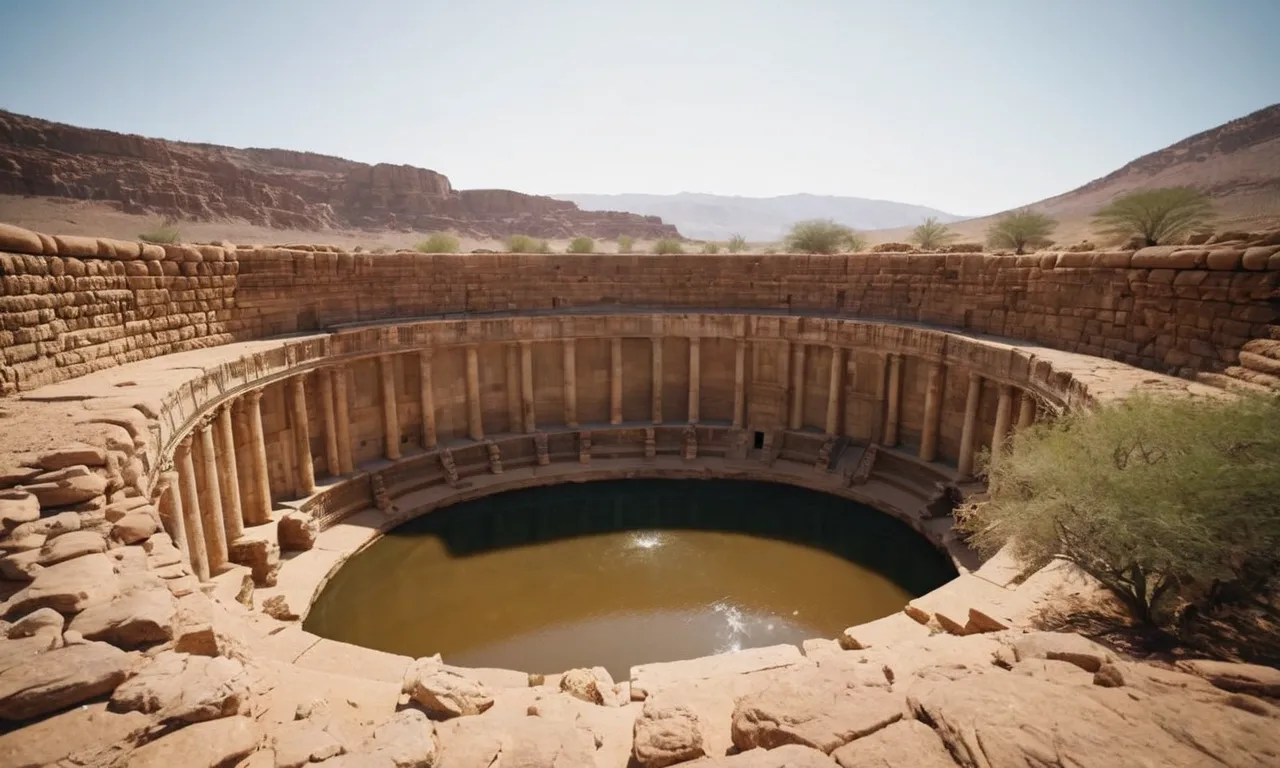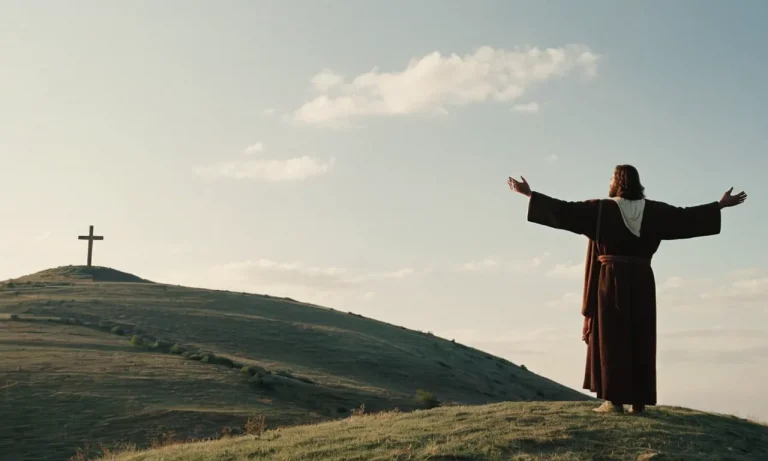What Is A Cistern In The Bible? A Comprehensive Guide
Cisterns were an integral part of life in Biblical times, capturing rainwater for drinking and other daily uses. If you’re short on time, here’s a quick answer to your question: Cisterns in the Bible were man-made reservoirs or water storage tanks commonly dug into the ground or carved out of rock and used to collect rainwater.
In this comprehensive guide, we will explore what cisterns were, why they were so important in ancient Israel, examples of cisterns in the Bible, how they were constructed and maintained, differences between cisterns and wells, and the significance of cisterns in Bible stories and prophecy.
What Were Cisterns in the Bible?
Definition and Function of a Cistern
A cistern in the Bible referred to a man-made reservoir or tank used to collect and store water. Cisterns were an essential source of water in ancient Israel and other arid regions of the Middle East where natural sources of water were scarce.
They allowed people to have access to water throughout the year, despite seasonal fluctuations in rainfall.
Cisterns were typically dug into the ground and lined with plaster to prevent seepage. Rainwater that fell on rooftops and courtyards would be channeled by pipes into the cistern. Some larger cisterns could hold up to 200,000 liters of water.
This stored water could then be accessed via a rope and bucket when needed.
The primary function of cisterns was to provide water for drinking, cooking, washing, livestock, and irrigation. Having access to stored water was literally a matter of life and death in the dry climate of Israel.
As such, cistern water was an extremely precious resource that was essential for survival.
Importance and Common Uses of Cisterns in Ancient Israel
Cisterns and other methods of water storage were vitally important in ancient Israel due to the relative lack of easily accessible natural sources of water compared to rainfall. The mountainous central highlands received plentiful rain, while coastal and inner plains areas, where most people lived, tended to have limited water supplies.
Domestic purposes: In cities, towns, and villages, nearly every house had its own cistern to capture rain falling on the roof and courtyard. This household reservoir provided water for the family’s daily needs like drinking, cooking, bathing, and cleaning.Agriculture: Cisterns enabled the storage of water for irrigation of crops in the typically long, dry summer months when rainfall ceased. Irrigation supported agriculture and food production.Livestock: Watering livestock was essential, as animals like sheep, goats, cattle, and camels constituted important economic resources. Cisterns and wells provided water for these domesticated animals.
Some common types of cisterns during biblical times included:
- Simple bottle-shaped pits dug into the earth.
- Elaborately constructed underground vaulted chambers lined with plaster.
- Pools built above ground and faced with stones.
| Estimated number of cisterns by era | Bronze Age: Over 250 Iron Age: At least 1,200 Byzantine Era: Over 2,000 |
As evidenced by Dr. Oded Borowski’s book Agriculture in Iron Age Israel, cisterns were absolutely vital to providing water that made agriculture and survival possible in ancient Israel. Sites like Khirbet Qumran give clues into how societies engineered complex water storage solutions with numerous interconnected cisterns.
Examples of Cisterns in the Bible
Jeremiah’s Cistern Experience
One of the most well-known stories involving a cistern is when the prophet Jeremiah was thrown into a cistern as punishment. King Zedekiah had imprisoned Jeremiah for prophesying the Babylonian conquest of Jerusalem.
The king’s officials did not like Jeremiah’s gloomy message and sought to silence him, so they threw him into an empty cistern where he sank down into the mud (Jeremiah 38:1-13). Jeremiah likely would have died there had not Ebed-Melech, a Cushite court official, pleaded with the king on Jeremiah’s behalf.
Ebed-Melech received permission to rescue Jeremiah from the cistern using ropes and old rags. God honored Ebed-Melech’s faithfulness and rescued him when Jerusalem fell to Nebuchadnezzar.
This vivid story illustrates how cisterns were sometimes used as temporary prisons or dungeons. Thankfully, Jeremiah survived his cistern experience and continued prophesying to the people. His example encourages believers today to faithfully speak God’s truth despite opposition.
The King’s Garden Cistern
During Nehemiah’s time, the returned Jewish exiles worked to rebuild Jerusalem’s walls that had been destroyed by the Babylonians. Some parts of the wall lay directly on top of cisterns from the old city.
One such cistern was the King’s Garden cistern located near the King’s upper palace (Nehemiah 3:15). The Bible notes that Shallun repaired the Fountain Gate section of the wall “and covered it and set its doors, its bolts, and its bars.”
The gate likely received its name from the nearby spring waters that flowed into the King’s Garden cistern.
This cistern perhaps dated back to King Hezekiah’s expansions when he diverted water from the Gihon Spring to store in royal pools and cisterns. The King’s Garden cistern provided reserves of water near the palace that nourished the royal gardens.
Though ancient ruins today, these cisterns remain a testament to Jerusalem’s early water system engineered for withstanding siege.
Hezekiah’s Water Works
One of the most impressive cistern projects in the Bible is King Hezekiah’s water works undertaken around 700 BC. As mentioned, he built a channel to divert water from the Gihon Spring outside the city walls into a reservoir within the city called the Pool of Siloam.
From there, the water flowed into other pools and cisterns he constructed to store large reserves of water in preparation for the Assyrian siege of Jerusalem (2 Chronicles 32:2-6, 30).
Archaeologists discovered Hezekiah’s tunnel in the 19th century. An ancient Hebrew inscription within the tunnel describes how the builders worked from two ends, calling to one another until they met in the middle.
Hezekiah’s ingenuity kept Jerusalem supplied with water during Sennacherib’s siege in 701 BC when access to springs outside the city was cut off. Cisterns helped Jerusalem withstand enemies, just as God protected His people.
Cistern Construction and Maintenance
How Cisterns Were Built
Cisterns in ancient Israel were carefully engineered to collect and store rainwater for both domestic and agricultural purposes. Their construction often involved intricate planning and labor.
Ideal locations for cistern building were areas with natural rock formations that could be carved out and shaped into water storage tanks. Quarries and limestone cliffs provided ready-made cistern walls that just needed hollowing.
Cisterns were also built underground, requiring diggers to painstakingly excavate soil and rock to form a deep cylindrical pit lined with plaster to prevent leakage.
Some larger cisterns were incredibly impressive in size and scope. The Pool of Siloam in Jerusalem had a capacity of over 2 million gallons and intricate masonry with stepped sides. Archaeologists believe over 100 workers were needed to construct it.
The cistern’s mouth had a broad stairway that descended down to the pool. Biblical Archeology notes this allowed groups to easily fill their jars with water.
Once the basic pit and walls of a cistern were complete, a thick waterproof plaster of lime, ash and ground charcoal was applied to prevent seepage. Maintaining this seal was vital to preventing contamination and leaks.
The final step was attaching gutters and pipes from rooftops or courtyards to channel rainwater into the cistern’s mouth.
Keeping Cisterns Clean
Due to their water sources, keeping cisterns clean was an essential but constant chore. Wind could blow dirt, debris and even small animals into open cisterns. Algae and microorganisms could also grow in the water over time.
To maintain purity, cisterns needed regular cleansing. This involved actively dredging out thick sediment and wiping down walls. Some cisterns had inner chambers that allowed good water to flow into the main pool while trapping heavier particulates.
Small openings prevented larger contaminants from entering.
The Bible gives insight into the importance of cistern hygiene and maintenance. Ecclesiastes mentions that a broken or damaged cistern allows life-giving water to seep away (Ecclesiastes 12:6). In Jeremiah 2:13, God rebukes His people for forsaking Him, “the fountain of living waters”, to worship false idols and dig their own man-made cisterns that can never provide water as pure and clean as His.
Proper cistern care took time and effort but helped ensure families had an ongoing supply of fresh water vital for ancient life. With attention to construction and cleaning, these water systems endured for generations.
Comparison of Cisterns and Wells
What’s the Difference?
Cisterns and wells are both ancient water collection systems, but there are some key differences between the two. Here’s an overview of how they compare:
- Location – Cisterns are usually built above ground or underground to store rainwater, while wells access groundwater by being dug into the earth.
- Water Source – Cisterns collect rainwater or stormwater runoff, while wells draw water up from underground aquifers.
- Construction – Cisterns are constructed containers made of materials like concrete, fiberglass, or plaster. Wells are holes excavated into the ground lined with tiles, bricks, stones, or concrete.
- Water Quality – Water stored in cisterns is more susceptible to contamination from birds, animals, debris, and organic matter. Well water drawn from underground is naturally filtered.
- Maintenance – Cisterns require regular cleaning, repairs and treatment to keep stored water fresh. Wells need less frequent maintenance but can accumulate mineral deposits over time.
- Cost – Constructing a cistern is often more affordable than drilling and developing a well.
Advantages and Disadvantages
Both cisterns and wells come with unique benefits and downsides:
Cistern Advantages:
- Harvests rainwater for conservation and water storage.
- Can be built above or below ground to prevent loss through evaporation.
- Low cost compared to drilling a well.
- Water can be used for non-potable purposes like gardening, washing.
Cistern Disadvantages:
- Requires regular maintenance and cleaning.
- Stored water is susceptible to contamination.
- Limited capacity depending on rainfall.
- May require filtration and treatment systems.
Well Advantages:
- Accesses groundwater so supply is not weather-dependent.
- Water is naturally filtered and cleaner.
- Minimal maintenance needed once constructed.
- Provides potable drinking water.
Well Disadvantages:
- More complex and costly to drill and develop.
- Possibility of running dry during droughts.
- Can require regular testing for contaminants.
- May produce hard water with high mineral content.
To summarize, cisterns provide affordable rainwater storage ideal for irrigation and washing. Wells tap into groundwater for a reliable, filtered source of drinking water, albeit at a higher installation cost. The choice between the two depends on water needs, budget, and site conditions.
Significance of Cisterns in Bible Stories and Prophecy
Symbolism in Certain Bible Accounts
Cisterns, as storage places for water, take on symbolic meaning in several Bible accounts. For example, the story of Joseph being thrown into a dry cistern by his brothers (Genesis 37) foreshadows Jesus, the beloved Son, being rejected.
The prophet Jeremiah being thrown into a muddy cistern and left to die (Jeremiah 38) also carries symbolic weight, as he prophesied judgment on Jerusalem shortly before its fall to Babylon. On a positive note, the woman at the well (John 4) encounters Jesus, the source of “living water,” illustrating how Christ satisfies spiritual thirst.
Overall, cisterns represent things from which we seek salvation and security, whether wisely or not.
Apocalyptic Imagery Using Cisterns
The Bible contains vivid cistern imagery especially in prophecies about the apocalypse. For example, the prophet Joel warns that “the sun shall be turned into darkness, and the moon into blood, before the great and terrible day of the LORD comes” (Joel 2:31).
This likely refers to ash and smoke clouds blocking the sun and moon during global war. Zephaniah also prophesies that during the “great day of the LORD” Armageddon, God will bring distress on people “who have become complacent” (Zephaniah 1:12, 15).
And Revelation depicts a star called Wormwood falling and poisoning global water sources during the apocalypse (Revelation 8:10-11). Overall, cisterns and water sources represent people’s only hope during such events.
As Jesus warns, when apocalyptic events occur, those who are spiritually unprepared will “fall into a pit” (Luke 14:5).
While frightening, such symbolism underscores why seeking God is humanity’s only sure salvation, regardless of circumstance. As King David wrote during trials, “The LORD is my rock, my fortress and my deliverer . . . my stronghold” (Psalm 18:2).
Even when cisterns—where people store their confidence—fail them, God remains a reliable source of hope and security for those who trust in Him.
Conclusion
As we have seen, cisterns played a vital role in providing sustenance to ancient communities in Israel and beyond. Though just humble reservoirs for capturing water, these stone-lined pits dynamically impacted people and shaped key events in Scripture, while also lending themselves powerfully to prophetic imagery and analogy.
When we understand what cisterns were and how heavily people depended on them, we gain a more robust comprehension of many Bible passages.








